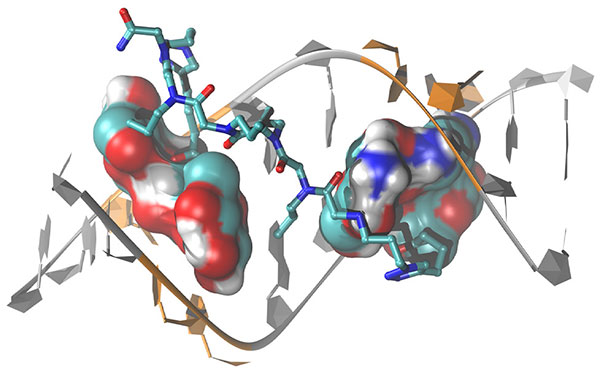By John Tibbetts
Ilyas Yildirim, Ph.D., is designing computer-aided methods to help develop breakthrough treatments for genetic neuromuscular disorders such as myotonic dystrophy and Huntington’s disease.
“We investigate the biology of biomolecular systems using theoretical and computational methods,” said Yildirim, assistant professor of chemistry and biochemistry in the Charles E. Schmidt College of Science. “We have an interdisciplinary program at the interface of biology, physics, chemistry and computer sciences to tackle challenging problems related to human diseases.”
“Drug treatments typically target proteins, but some incurable diseases do not respond to that approach,” Yildirim said. Over the last 15 years, researchers have been increasingly studying how to develop treatments that can target RNA instead, he said.
Human cells use RNA transcription to synthesize necessary proteins for proper functioning. In rare genetic cases, however, RNA can go haywire. For instance, in trinucleotide repeat expansions, also known as triplet repeat expansion, thousands of copies of a specific RNA sequence are transcribed. This leads to either the production of toxic proteins or interactions with cellular proteins, disrupting critical motor functions. Targeting these RNA molecules with small molecules can offer cures for these diseases. Several of these diseases include myotonic dystrophy type 1, a genetic disease of progressive muscle weakening and wasting; Huntington’s disease, an inherited disorder that causes nerve cells in parts of the brain to gradually break down and die; and fragile X syndrome, a genetic disorder, where people do not make a protein needed for brain development.
“Currently, there are no identified solutions for many of these diseases in which the normal functions of RNA within the cell are compromised ,” said Yildirim, who earned a doctorate and master’s degrees in physics from the University of Rochester, New York. He earned his bachelor’s degree in physics from Koc University in Turkey. Before coming to Florida Atlantic, he was a postdoctoral researcher at the University of Rochester, Northwestern University, and University of Cambridge in the United Kingdom.
RNA molecules have highly dynamic “loop” motifs, where therapeutic molecules can dock to stop genetic defects responsible for neuromuscular diseases. Yildirim and his team created novel computational methods to predict the mechanisms and reasons behind the binding of small molecules to RNA loop motifs, which can be applied in drug design.
“We don’t do wet-lab experiments,” Yildirim said. “Instead, we employ computational methods to make predictions. We have developed a computational method called dynamic docking.” This tool predicts the binding affinities and binding modes within the available energy landscape of an RNA binding site. By using this approach, researchers can determine whether small molecules are likely to target a binding site. “We believe it could predict the optimal binding mode of a small molecule that targets any type of an RNA motif,” said Yildirim, who is also a member of the Stiles-Nicholson Brain Institute.
Randy Blakely, Ph.D., executive director of the Brain Institute, said Yildirim’s research, which was recently published in Biophysical Journal, is groundbreaking and could change the future of treatment for brain disorders. “This research lays a foundation in making drugs to treat brain disorders via manipulations of RNA molecules,” Blakely said.

